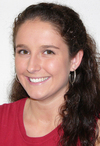Pre-med student has memorable trip to Brazil

A Chadron State College student said she visited “a very different world” this past summer. While the trip had its tense moments, the kind you’d expect when you accidentally touch an anaconda or see a spider as big as a dinner plate, she said she’d “go back in a second if I had a chance.”
Tessa Dormann, a senior pre-medicine major from Mitchell, spent about 20 days visiting Brazil as a participant in the 2004 International Mission on Medicine. She was nominated for the experience by Dr. Brad Fillmore, who teaches anatomy and physiology at CSC. About 60 pre-med students from throughout the U.S. were selected to take part. The arrangements were made through Envisions, an international program that encourages American college students to visit other countries and learn new cultures.
“It was an amazing experience,” Dormann said. “I saw so much and learned so much. It was fun and it was educational. I really felt like I was helping people. The trip definitely confirmed my decision to become a doctor.”
The trip was one of sharp contrasts, much like the Brazilian culture. The doctors-to-be stayed in everything from five-star hotels to bamboo huts. They saw some of the world’s best medical facilities and met indigenous people who live several days from any medical care. They also observed a variety of lifestyles ranging from luxurious to abject poverty.
The trip opened with stops in major cities such as Rio de Janeiro, Salvador and Manaus, where most of Brazil’s leading research and health care facilities are located. One of the most fascinating experiences was in Rio, where Dr. Ivo Pitanguy, one of world’s leading plastic surgeons came to the hotel where the Americans were staying and gave a power point presentation on his work. A couple of patients whose faces he had reconstructed accompanied him
“Lots of people who have been burned or been in horrible accidents come to him,” she said. “He does some great things for them.”
The CSC honor student said nearly all of the world’s leading pharmaceutical firms have research facilities in Brazil as they search for plants that can be used for medicinal purposes.
“Many of them feel the Amazon Basin has the answer for every health problem,” Dormann said. “There are many scientists there collecting plants and testing them to see if they can find those answers.”
But Brazil definitely has its share of health problems. She said it has the second highest incidence of AIDS in the world behind only South Africa, has nearly all the tropical diseases such as malaria and yellow fever, many insect-borne diseases are prevalent and there are problems caused by the array of exotic animals and reptiles that inhabit the jungles.
One of Dormann’s most memorable experiences was watching doctors amputate the leg of a man who had been bitten by a cobra. She also saw the leader of a tour she was taking have his hand severely bitten by an alligator.
The last few days of the trip was a survival experience in the jungle along the Amazon. The American students lived in huts where their dinner mates included monkeys and macaw parrots. It was during this period that the visiting students observed doctors, many of them on leave from their practices in the United States, working out of houseboats that have been converted into clinics to serve the needs of natives who use the river and its tributaries as their main source of transportation.
“Some of the people live up to 10 days away from where the boats are located. It takes them forever to get medical assistance. That’s what happened to the guy who had been bitten by the cobra. It had taken him too long to get help and they couldn’t save his leg.”
Dormann noted that the doctors also learn from the people they treat. She said through the centuries, Brazilians have discovered much about the healing powers of the plants that flourish in the region.
The floating clinics also serve as inoculation centers and to dispense medicines to treat parasitic diseases and other health problems, including those caused by the lack of essential elements in the diets.
It was while seeing the sights in the jungle that several students accidentally touched an anaconda that was hanging among the vines from a tree and blended in well with the branches.
“I really freaked out. It took my breath away,” she said with emphasis. The adult snakes are from 15 to 20 feet long and weigh up to 260 pounds, she later learned.
“I’m not sure the one I saw and the others touched was that big. I was so scared that I can’t remember too much about it.”
Dormann, who is active in five organizations and also serves as a tutor at Chadron State, said while Brazil has many health care problems, she thinks it does have its advantages. Medical treatment is free to all citizens and the government pays the tab for all medical school students. Because of the latter system, youths who grow up in the lower economic classes can become doctors and nurses if they meet the entrance requirements.
Most Brazilian youths who go to medical schools begin their training directly out of high school and skip the four years of college that American students experience before going for their professional training.
With another year at Chadron State and at least four years of med school ahead of her, Dormann doesn’t know what her future in medicine holds. But she said she’s sure that someday she’ll return to either Brazil or similar places to share her medical expertise with people who desperately need it.
Category: Campus News, Physical and Life Sciences
